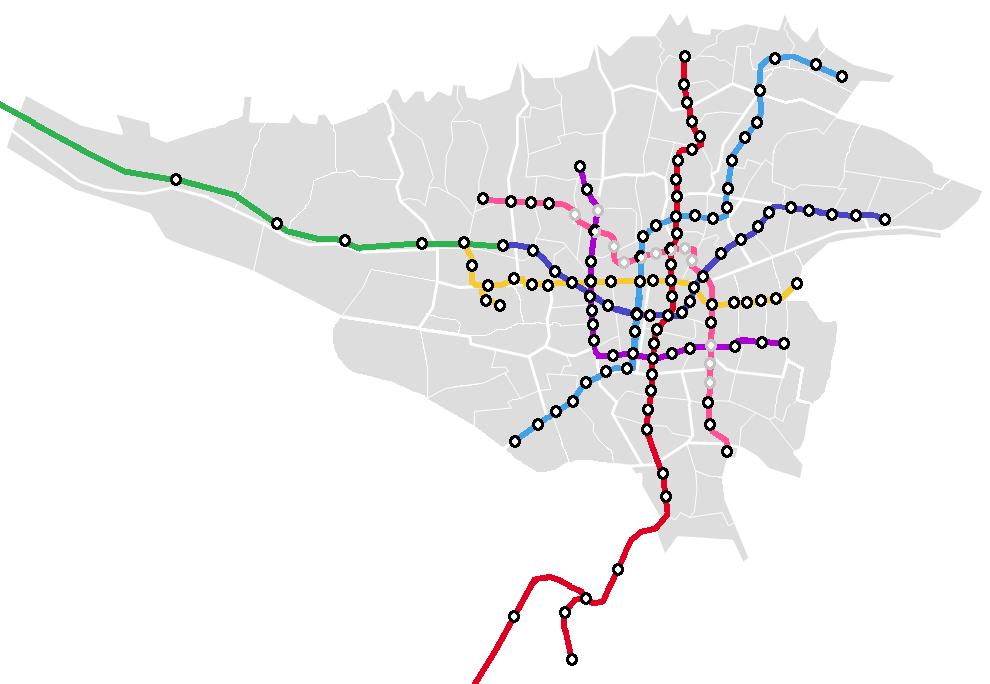Getting around Tehran on a reliable public transportation system is a breeze. Tehran has a diverse public transit system that includes buses, metros, trams, and taxis. With 7 lines, 150 stops, and fares beginning at roughly $0.30, the Tehran Metro is easily the most used mode of public transportation in the city. The bus system is extensive, with over a hundred routes and tickets as low as $0.10. In addition to taxis, trams may also be used for local transportation. Tehran’s public transportation is cheap, quick, and secure across the board.
Metro system in Tehran – مترو تهران
Tehran’s metro is one of the city’s best means of public transit. There are seven lines totaling more than 168 kilometers of track that are managed by the Tehran Urban and Suburban Railway Operation Company. The Tehran Metro has been running since 1999, making it the first such system in the Middle East. The average daily ridership is approximately 3 million, making it one of the busiest metro systems in the world. It can reach speeds of up to 100 km/h, making it the fastest metro in the world. Tehran’s subway system, or metro, is a fantastic method to travel around the city.
The lines of the Tehran subway system
Line 1 – Red
Line 1 is red on system maps. 14.9 kilometers of its 67.9 kilometers are subterranean (between Tajrish station and Shoush-Khayyam bridge). This route has 31 stations—23 subterranean and 8 aboveground. Trains stop for 20 seconds each. Each train has seven wagons and seats 1,300 people.
Line 2 – Blue
Sadeghieh and Imam Khomeini connected in February 2000. Line 2 covers 26 km. Line 1 uses Imam Khomeini Station, one of 22 stations. Line 2 crosses the city east-west.
Line 3 – Light Blue
The direction of Line 3’s route is northeast to southwest. The third line is crucial since it crosses the most congested areas of the metropolis and connects the southwest and northeastern regions of Tehran. The total length of the line is 33.7 km and it has 25 stations.
Line 4 – Yellow
It connects western and eastern Tehran with 23 stops across 24.4 kilometers. This road first connects Ekbatan in western Tehran to Kolahdooz in eastern Tehran. Bimeh station has a branch to Mehrabad International Airport. This branch line stops at Terminals 1-4 and Terminals 4-6 in Bimeh.
Line 5 – Green
On maps of the entire system, route 5 is shown in green; it is a commuting train route that is 67.5 kilometers long and stops at 12 different locations. Karaj, Golshahr, and Hashtgerd serve as major hubs as you enter the region. Line 2’s western terminus is in Tehran (Sadeghiyeh), and Line 4’s western terminus is at Eram-e Sabz.
Line 6 – Pink
On route diagrams, Line 6 is depicted in pink. There are currently 13 stops over its 16.5 km length. When finished, this line will stretch 38 kilometers in length and connect Tehran’s southeast and northwest.
Line 7
Line 7, like line 6 but unlike line 3, runs in a northwest-to-southeast direction. Currently, there are 20 stations over its 22 km length.
Map of Tehran Metro 2023 – Free Download in PDF

Click and download the map of Tehran’s underground system for 2023
The PDF version of the Map of Tehran Metro 2023 is available for free download, simplifying travel throughout Iran’s capital. It provides an all-encompassing map of the metro system, detailing every line, station, fare zone, transfer point, and more. Using this map, you may quickly find the most direct route, or save it for future reference as a backup plan. It’s a must-have for getting around the city and staying in touch with friends and family back home.
Public transport tickets in Tehran – Best types for travelers & actual prices
One of the most common ways to get around Tehran is by bus. At the bus stops, you may get tickets for around 10,000 IRR, or $0.30 USD. Tickets can be purchased for either a single ride or for the entire day. Daily passes are available for 25,000 IRR ($0.75 USD).
The metro system is widely used by Tehran residents and visitors alike. You can buy tickets for 10,000 IRR ($0.30 USD) at any of the metro stops. Daily tickets cost 25,000 IRR ($0.75 USD) and are available.
The minibus network is the most cost-effective option for getting about Tehran. Minibus stops selling tickets for 5,000 IRR ($0.15 USD). All-day passes for minibusses are not offered.
If you’re going to be in Tehran for three days, you should get an all-day bus or metro pass. You’ll be able to go around the city quickly and cheaply using this. The all-day ticket is the most practical choice because it allows you to ride the city’s public transit system as many as you like without having to buy separate tickets.
Summary of fares for public transport in Tehran
- Single-ride bus tickets are 10,000 IRR ($0.30 USD) and day passes are 25,000 IRR ($0.75 USD).
- Single ride tickets on the Metro cost 10,000 IRR ($0.30 USD), while daily passes cost 25,000 IRR ($0.75 USD).
- The cost of a ride in a minibus is 5,000 IRR, or around $0.15 USD.
Timetables & Schedules of the Tehran Metro system
The last train of the day leaves the Tehran Metro station at 10:30 p.m., and service runs from 5:30 a.m. to 11:00 p.m. Stations are serviced every 5 minutes during rush hours and every 10 minutes during off-peak times by trains. Line 1 runs north to south, Line 2 runs east to west, Line 3 runs north to south, and Line 4 runs east to west; these are the four lines that make up the metro system. Central stations in the city are linked to the airport via Imam Khomeini International Airport.
What Are Other Options For Public Transportation In Tehran?
There is an abundance of public transit choices in Tehran. There are also buses, cabs, and ridesharing apps in addition to the subway. Buses are a popular choice for getting around town, and there are routes all across town. Taxis can also be taken, however, they will cost more than the bus. At last, ridesharing applications like Snapp and Tap30 let you get a ride and pay using a credit card or a mobile wallet. These services are growing in popularity in Tehran since they make getting about the city easy.
how does the public bus transportation work in Tehran
The city of Tehran relies heavily on its public bus system. Hundreds of buses circulate the large metropolis, making public transportation the most used option. Tehran’s public transportation system makes it simple to navigate around the city.
The Tehran Urban and Suburban Bus Company (TUSBC), a division of the Tehran Municipality, is in charge of the city’s bus system. More than 800 buses run for the company on over 200 routes, serving the whole city and its surrounding suburbs. The buses are frequently updated and well-equipped; they also come in a range of sizes to meet the needs of different groups.
Public bus rides in Tehran are cheap and the fee is calculated by how far you need to travel. The typical cost of a fare in Iran is between 1,000 and 3,000 Rials, or around $0.05 and $0.15 US. Although cash is the preferred method of payment on most buses in Tehran, public transportation cards can be obtained from metro and bus stations.
The T-51, T-45, T-41, T-43, T-52, T-47, and T-48 bus lines are the most frequently used in Tehran. These buses go between the city’s major neighborhoods, and their routes are clearly signposted. The Municipality of Tehran has also developed a smartphone application (app) called Tehran Bus that provides information on the schedules and locations of all the city’s public buses.
How do the public TRAINS work in Tehran?
In Tehran, the train system is an integral aspect of the public transportation system. Railways of the Islamic Republic of Iran (RAI) connect Tehran and other major cities in Iran with the rest of the country. In this piece, we’ll examine Tehran’s public transit system and its most vital connections to neighboring cities.
It is easy and inexpensive to go around Tehran by taking the public train system. The RAI manages a system of local, suburban, and intercity train lines in the metro area. Passengers can buy one-time rides or subscriptions to the service through a ticket window or automated kiosk. Remember to check your tickets for validity before boarding the train.
Regional rail services linking Tehran to other cities are also run by the RAI. Isfahan, Shiraz, Mashhad, and Rasht are all easily accessible because to these regularly scheduled intercity services. Cities in Turkey, Armenia, Azerbaijan, Turkmenistan, and Uzbekistan are served by the RAI’s international routes.
The RAI provides regular train service as well as express service along several lines. These services are typically more expensive than standard services since they are more expedient and comfortable.
How To Get From Tehran Imam Khomeini International Airport (IKA) To The City Center With Public Transport?
Taking public transportation from Tehran’s Imam Khomeini International Airport to the heart of the city is the most convenient option. The Imam Khomeini International Airport, only 25 kilometers (16 miles) south of Tehran, serves as the country’s primary airport for both international and domestic flights. Travelers can get into the heart of the city without breaking a sweat because to the airport’s proximity to public transportation hubs.
Airport shuttle buses are the most reasonably priced means of transportation. This shuttle runs everyday from 6 am to 9 pm from the airport to the downtown area. The bus leaves the airport every 30 minutes towards the city center, and the ride takes around 40 minutes. The bus terminal is outside the arrivals hall, and tickets are sold there for 25,000 Rials (about $2 USD).
From the heart of Tehran, you can take the metro to the airport, or take the airport shuttle bus. The airport is about a 40-minute metro ride away during the metro’s 5:15am-10:30pm daily operating hours. A ticket will set you back 5,000 Rials, or about $0.40. Keep in mind, though, that the subway is closed on the weekends.
There is no shortage of taxis if you prefer that mode of transportation. It takes about 45 minutes to get to the heart of the city in a taxi from the airport. Prices start at roughly 150,000 Rials, or around $12 USD, but may be higher or lower depending on where you’re going.
how to spend 3 days in Tehran?
This guide is for you if you’re just going to be in Tehran for a few days but yet want to see as much as possible. We’ve designed a three-day itinerary that’ll make your first trip to the city one you’ll never forget.
First Day
Get the day started right by visiting some of Tehran’s many museums and monuments. See the Golestan Palace and the Grand Bazaar while you’re in the area. Explore the maze of stores and marvel at the magnificent palace all in one visit. Then, visit Milad Tower, one of the world’s highest buildings. Take in the breathtaking panoramas of the city from this vantage point. Visit the National Museum of Iran towards the end of the day to gain insight into the region’s rich history and culture.
Second Day Time Period
Learn about Tehran’s contemporary side on day two. Valiasr Street is the longest street in all of the Middle East, and it is well worth a stroll. You may go shopping, check out the street art, and enjoy the lively scene all in one place. Visit the Azadi Tower, a symbol of Tehran and the Iranian Revolution, afterward. In the evening, make a reservation at a restaurant recommended by a resident. Kebab, the-chin, and fesenjan are just a few of the tasty traditional meals you must try.
Third-Day
On your final day in Tehran, make the most of the vibrant nightlife scene. Spend an evening dancing at one of the city’s many bars or clubs. Try a shisha and a cup of tea at one of the local cafés for a more relaxed experience.
What other metro systems are nearby to Tehran?
While the Tehran Metro is the largest of Iran’s metro systems, there are several smaller cities close to the capital that also have their own. The Tabriz Metro is Iran’s second-largest, serving the city of Tabriz. Mashhad’s metro system, known as the Mashhad Metro, ranks as Iran’s third-largest. Shiraz’s metro system, Shiraz Metro, is the country’s fourth-largest. Tehran is not the only city in the area with a metro system; Ahvaz and Isfahan each have their own. All of these cities’ subways are accessible from Tehran, making day trips to and from them a breeze.
Summary of our tour guide for Tehran
I have lived in Tehran for five years and have relied on the city’s public transit system throughout that time. The city and its public transit system have grown and changed during my time here. Getting around is less of a hassle and more convenient than ever thanks to the subway, buses, and taxis. Rapid, dependable, and cheap service is yours to enjoy on the subway. You can get just about anywhere in the city by taking a bus, which is abundant. Those who would rather not use the subway or bus can easily and conveniently take a taxi. Alternative modes of transportation, such as ridesharing, are also an option. In my experience, the public transportation system in Tehran is the best option for getting around the city.
Top 5 FAQs and answers about Tehran public transport?
Where can I find out first-hand about Tehran’s public transportation options?
- Tehran’s public transportation system includes the metro, city buses, and taxis. To move around Tehran quickly and cheaply, use the subway. Line 1 has the most ridership out of the existing eight lines. In addition to the metro, you can also take buses to get where the metro doesn’t go. Taxis are more costly, yet convenient for shorter trips.
How much do fares typically cost on Tehran’s public transportation system?
- In Tehran, the cost of taking the subway, bus, or taxi will vary according on your mode of travel. Prices for metro rides range from 5,000 to 8,000 Iranian Rials (IRR). Prices for bus rides range from 4,000 to 8,000 IRR. Taxi fares begin at 10,000 IRR and increase with the distance traveled.
How can you acquire metro passes in Tehran, question 3?
- Purchasing a metro ticket is possible at any stop. Either a one-time use ticket or a reusable smart card is available for purchase. The smart card can be reloaded and used several times, while the single-ride tickets can only be used once.
How do I move around Tehran most efficiently, question 4?
- To get around Tehran quickly and easily, use the subway. It’s brisk, productive, and economical. It’s the greatest way to see the city’s top attractions while avoiding gridlock.
Is it safe to take public transportation in Tehran?
- Tehran’s public transportation system is relatively secure. Still, it’s crucial to have your wits about you and to take all appropriate safety measures. It’s smart to travel in convoys and stay away from trips at odd hours.
Useful links






